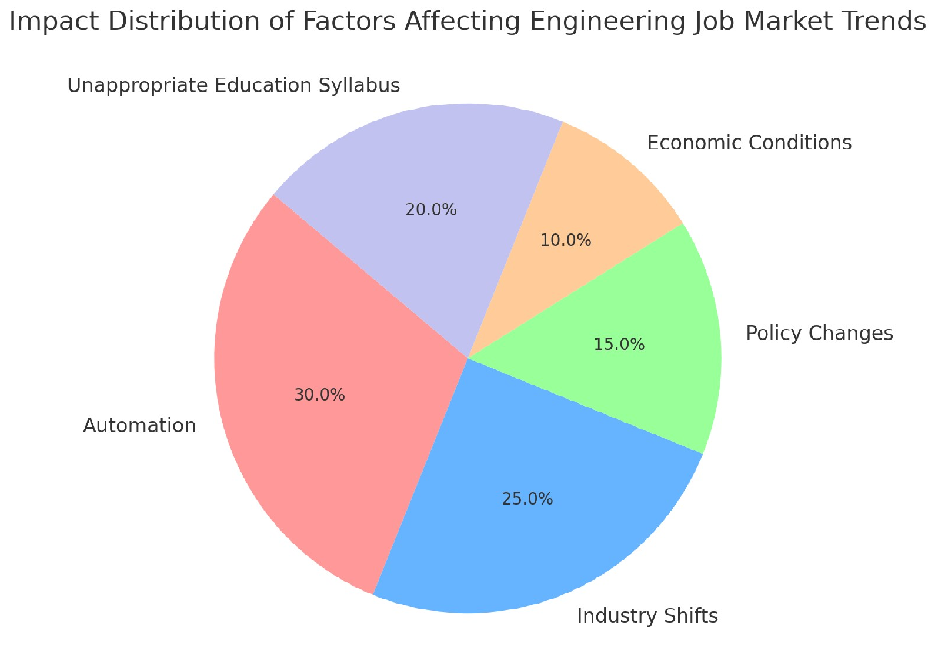User Ideas / Prospects

Elaboration on Factors Affecting Engineering Graduate Unemployment
This pie chart reflects how different factors contribute to unemployment among engineering graduates. The percentage significance of each factor is estimated based on industry reports, trends, and market analysis. Let’s break them down:
1. Automation (30%) – Most Impactful Factor
Why It’s Significant?
- Replacement of Jobs: AI, robotics, and software-driven automation are replacing traditional engineering roles in manufacturing, design, and even coding.
- Industry 4.0 Transformation: Smart factories, IoT-enabled systems, and AI-driven quality control have reduced the need for manual intervention in mechanical, electrical, and civil engineering fields.
- Software & AI in Engineering Design: With AI-powered design software, tasks that previously required teams of engineers can now be done by a single AI-assisted engineer.
Affected Fields:
- Mechanical & Electrical Engineering (due to automated manufacturing and smart grid tech).
- Civil Engineering (AI-driven construction management tools).
- Software Engineering (low-code and AI-based programming replacing entry-level developers).
Why 30%?
- Major industries (automobile, electronics, construction) are rapidly shifting towards automated processes, leading to job displacement.
- AI-driven platforms like ChatGPT, GitHub Copilot, and AI-aided simulation software are reducing demand for junior engineers.
- Reports from McKinsey, WEF, and NASSCOM estimate 30-40% of engineering jobs could be at risk due to automation.
2. Industry Shifts (25%)
Why It’s Significant?
- Some engineering fields are growing (e.g., AI, space tech, electric vehicles), while others are shrinking (e.g., petroleum, coal, conventional auto manufacturing).
- Changing Skill Requirements: Employers now demand knowledge in AI, cloud computing, cybersecurity, and automation, which traditional engineers often lack.
- Engineering Specializations Becoming Obsolete: Decline in jobs related to oil & gas, thermal power, and traditional mechanical roles.
Affected Fields:
- Chemical Engineering (reduced petrochemical industry jobs).
- Electrical Engineering (shift from traditional power grids to renewables).
- Mechanical Engineering (reduced demand for combustion engine specialists).
Why 25%?
- As per reports from World Economic Forum (WEF) & NITI Aayog, one-fourth of current engineering roles will transform within the next decade.
- Shifts in automobile (EVs vs. ICE cars), energy (solar vs. coal), and manufacturing (3D printing, robotics) have forced engineers to upskill or risk unemployment.
3. Unappropriate Education Syllabus (20%)
Why It’s Significant?
- Curriculum vs. Industry Needs Mismatch: Engineering students are still being taught outdated subjects (e.g., Fortran programming, traditional power systems) while industries need AI, cloud, IoT, and automation knowledge.
- Lack of Practical Skills: Many graduates struggle with hands-on problem-solving due to insufficient exposure to real-world engineering applications.
- No Industry-Academia Collaboration: Colleges don’t update their curriculum based on market trends, leaving graduates ill-prepared for current job demands.
Affected Fields:
- All Engineering Fields, but especially Mechanical, Civil, and Electrical Engineering, where modern software tools (like MATLAB, ANSYS, SolidWorks) are not effectively taught.
Why 20%?
- Studies from AICTE (India) and IEEE suggest nearly 50% of engineering graduates in India remain unemployed due to lack of industry-ready skills.
- Many universities take 5-10 years to update their syllabus, which lags behind fast-moving tech trends.
4. Policy Changes (15%)
Why It’s Significant?
- Governments’ Focus on Sustainability: Stricter environmental laws are reducing job availability in oil & gas, thermal power, and chemical engineering sectors.
- Limited Public Infrastructure Projects: Slower execution of government-funded projects affects civil engineers and public sector job seekers.
- Visa & Outsourcing Regulations: Countries like the USA & UK are restricting H-1B work visas, affecting Indian engineers looking for overseas jobs.
Affected Fields:
- Civil Engineering (due to slow infrastructure policy changes).
- Chemical & Petroleum Engineering (due to climate laws and bans on single-use plastics).
- Software Engineers (due to visa restrictions in major IT outsourcing countries).
Why 15%?
- Policy-driven job losses are more localized (e.g., India’s ban on plastic affects Chemical Engineers, but not all engineers).
- Government funding delays in engineering projects result in temporary employment dips rather than permanent changes.
5. Economic Conditions (10%) – Least Impactful Factor
Why It’s Significant?
- Recession & Slow GDP Growth: Global slowdowns reduce hiring across industries.
- Startup Failures: Engineering startups often fail due to funding issues, reducing hiring for young engineers.
- Pandemic Aftermath: While COVID-19 boosted some fields (biotech, software), it harmed others (aviation, manufacturing).
Affected Fields:
- Aerospace & Mechanical Engineering (due to lower aircraft demand).
- Manufacturing-based Engineers (factories shutting down post-pandemic).
Why 10%?
- Economic conditions fluctuate but do not permanently impact engineering jobs.
- Engineering is still a backbone industry, meaning it recovers faster from economic downturns compared to other sectors like retail or tourism.
Key Takeaways from the Analysis
- Automation (30%) & Industry Shifts (25%) are the top two reasons for engineering job market disruptions.
- Outdated Education Syllabus (20%) remains a major hidden cause of unemployment.
- Policy Changes (15%) & Economic Conditions (10%) play a moderate to low role in overall job availability.
- Engineers who upskill in AI, automation, and sustainable technologies will be in higher demand.
